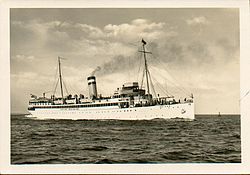Kaiser (ship, 1905)
|
The Kaiser after the renovation in 1922
|
||||||||||||||||||||||
|
||||||||||||||||||||||
|
||||||||||||||||||||||
|
||||||||||||||||||||||
|
||||||||||||||||||||||
The Emperor was a passenger ship of Hapag . She was the first civil German ship with steam turbines of German design and manufacture.
technology
The Kaiser was equipped with two turbines built by AEG - Berlin within seven months according to the Charles Gordon Curtis system, each of 2,208 kW (3,000 hp). These were 5.6 m long and 2.7 m high. The mass is given as 114 to 157 t. The large dimensions and masses resulted from the design as direct turbines, which were connected to the propeller shaft without a gearbox . Since there were no reduction gears, the turbines, which could not be run at the high speeds required for economical operation, had a low level of efficiency. The Kaiser thus reached a speed of 16 knots , occasionally 20 knots are given in the literature. During the renovation in 1923, a machine system with a total output of 3,000 hp was installed. Later, Blohm & Voss switched from coal to oil firing.
The Kaiser was approved for 1,949 deck passengers. Cabins in first class were available for 20 passengers.
history
The Kaiser was commissioned in 1904 by Nordsee-Linie Dampfschiffs-GmbH from Stettiner Maschinenbau AG Vulcan . When HAPAG took over the North Sea Line on January 1, 1905, it and their three other ships - Cobra , Princess Heinrich and Silvana - also bought the Kaiser , which was still under construction on the slipway . The launch took place on April 8th, the commissioning on September 10th, 1905. The Kaiser was used in the service Hamburg - Helgoland and from there to Sylt or Norderney . The travel time from St. Pauli Landungsbrücken to Helgoland was around four and a half hours, and from there to Norderney another three hours. Kaiser Wilhelm II used the ship on occasional trips on the North Sea .
First World War
The Imperial Navy captured the emperors on August 4, 1914 and had them converted into an auxiliary mineship, with the rear chimney removed. The ship could hold up to 200 mines . Under the command of Korvettenkapitän von Bülow, together with the mining cruisers SMS Albatross and SMS Nautilus , it laid a major mine barrier in the North Sea on September 9, 1914 . The speed of the Kaiser turned out to be too slow for a warship . At the end of the First World War , she was the flagship of the outpost flotilla “Elbe” under frigate captain Erich Graf von Zeppelin . In 1918 she was damaged by a mine hit and had to be made ready to go again at a repair yard.
Interwar period
The Kaiser had to be delivered to Great Britain in August 1919 . However, it was not put into operation there, but could be bought back by HAPAG on September 23, 1921. In 1922, the Bremer Vulkan shipbuilding and machine factory in Vegesack was converted . She received a new machine with a lower output.
On June 17, 1923 there was a collision between the British steamship Bellbro and the Kaiser below the Stör . The starboard side of the Kaiser was damaged above the waterline. One in 1,887 passengers was killed and four seriously injured.
Initially again in service from Hamburg to Helgoland and deployed to Amrum , Föhr and Sylt , the Kaiser drove from July 1, 1934, equipped with additional cabins, for sea service in East Prussia .
Second World War
During the Second World War , the Kaiser was converted into a mine ship by the Navy . It was armed with two 8.8 cm cannons and could hold up to 180 mines. She was temporarily under the command of Carl Kircheiß and was used from 1943 as a test ship of the Kriegsmarine.
post war period
After the war the Kaiser was delivered to Great Britain, from where it was delivered to the Soviet Union in 1946 . After she was neither under the British nor under the Soviet flag as Nekrasov , she was handed over to the People's Republic of Poland in April 1947 . As Beniowski it was, after the overhaul of the machinery in Earle's Shipbuilding & Engineering Co. in the UK and subsequent repairs at the Gdansk shipyard Stocznia Pologna , on 22 July 1948 by the shipping company "Gryf" Zegluga Przbrzenza on the route Sopot - Gdynia - Szczecin used. In 1949 she became a training ship for the Polish Navy. The Beniowski was laid up in Gdynia from 1950 and served as a stationary training and accommodation ship in Stettin until it was demolished in 1954 .
Individual evidence
- ↑ Archive link ( Memento of the original from June 26, 2012 in the Internet Archive ) Info: The archive link was inserted automatically and has not yet been checked. Please check the original and archive link according to the instructions and then remove this notice.
- ↑ Piwowonski, p. 96
literature
- Alfred Dudszus, Alfred Köpcke: The big book of ship types. Volume 2: Steam ships, motor ships, marine technology. From the beginnings of the machine-driven ships to the present day. transpress Pietsch, Stuttgart 1990, ISBN 3-344-00374-7 , p. 168.
- Claus Rothe: German seaside ships. 1830 to 1939 (= library of ship types. ). transpress Verlag für Verkehrwesen, Berlin 1989, ISBN 3-344-00393-3 , pp. 89-91.
- Jan Piwowoński: Flota spod biało-czerwonej [Fleet under white and red] , Nasza Księgarnia Publishing House, Warsaw 1989, ISBN 83-10-08902-3 .
